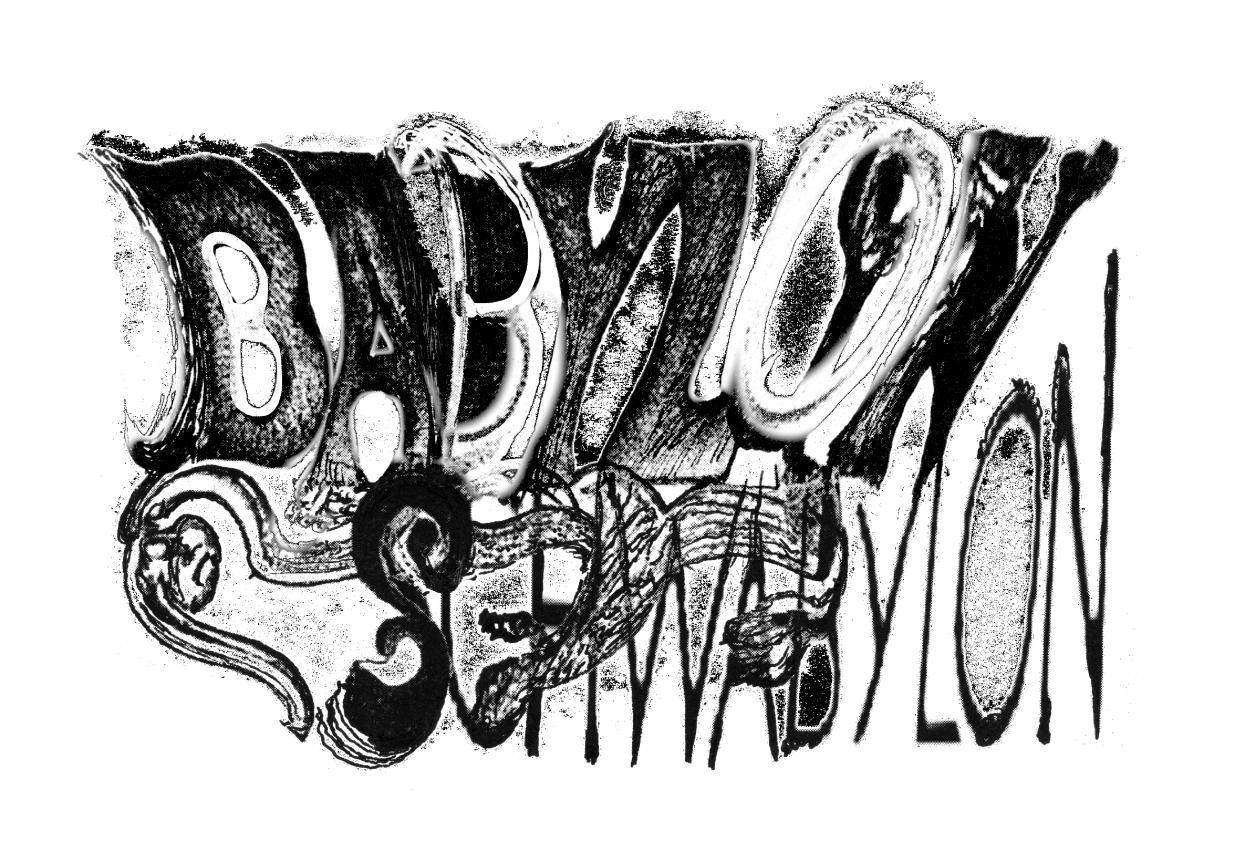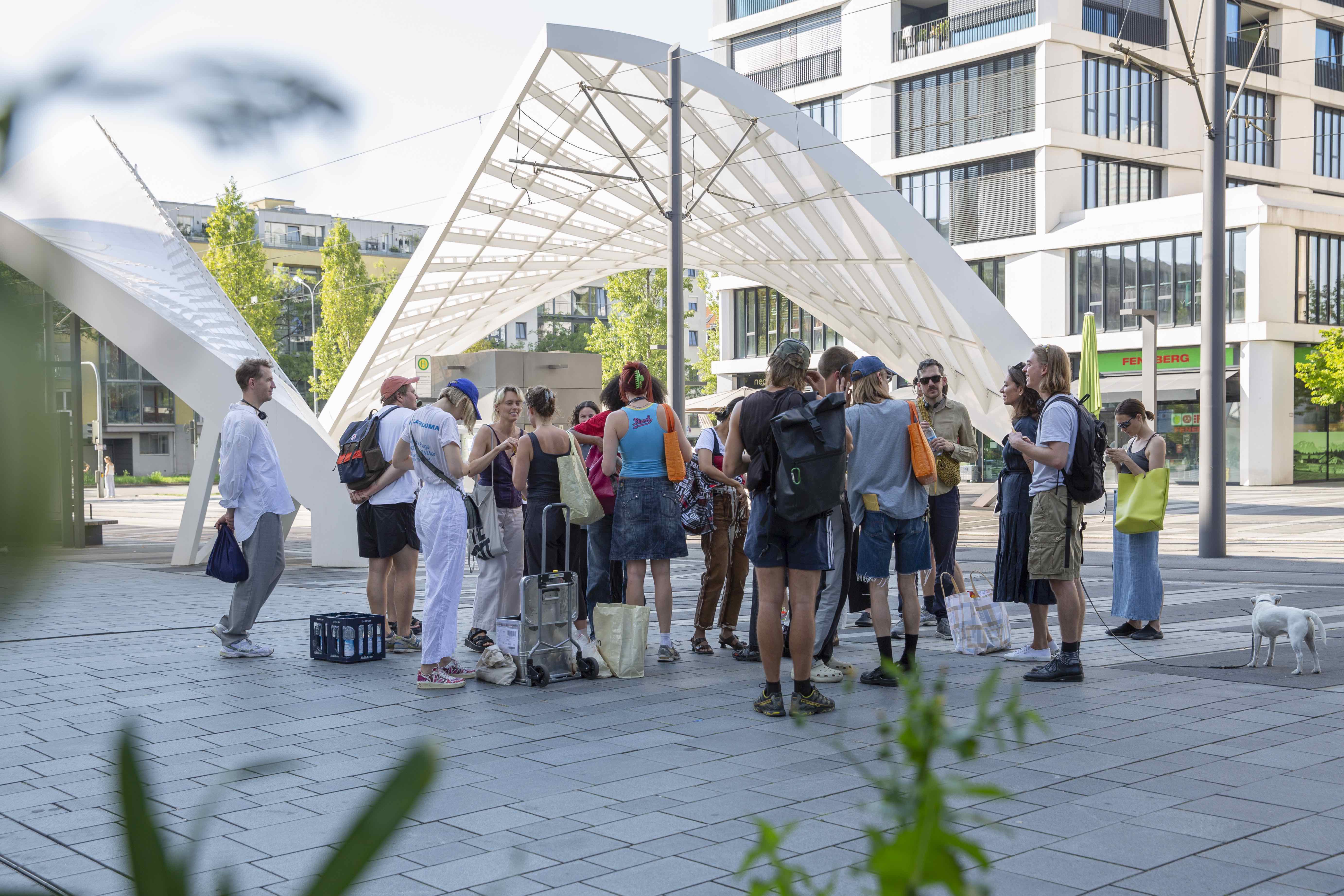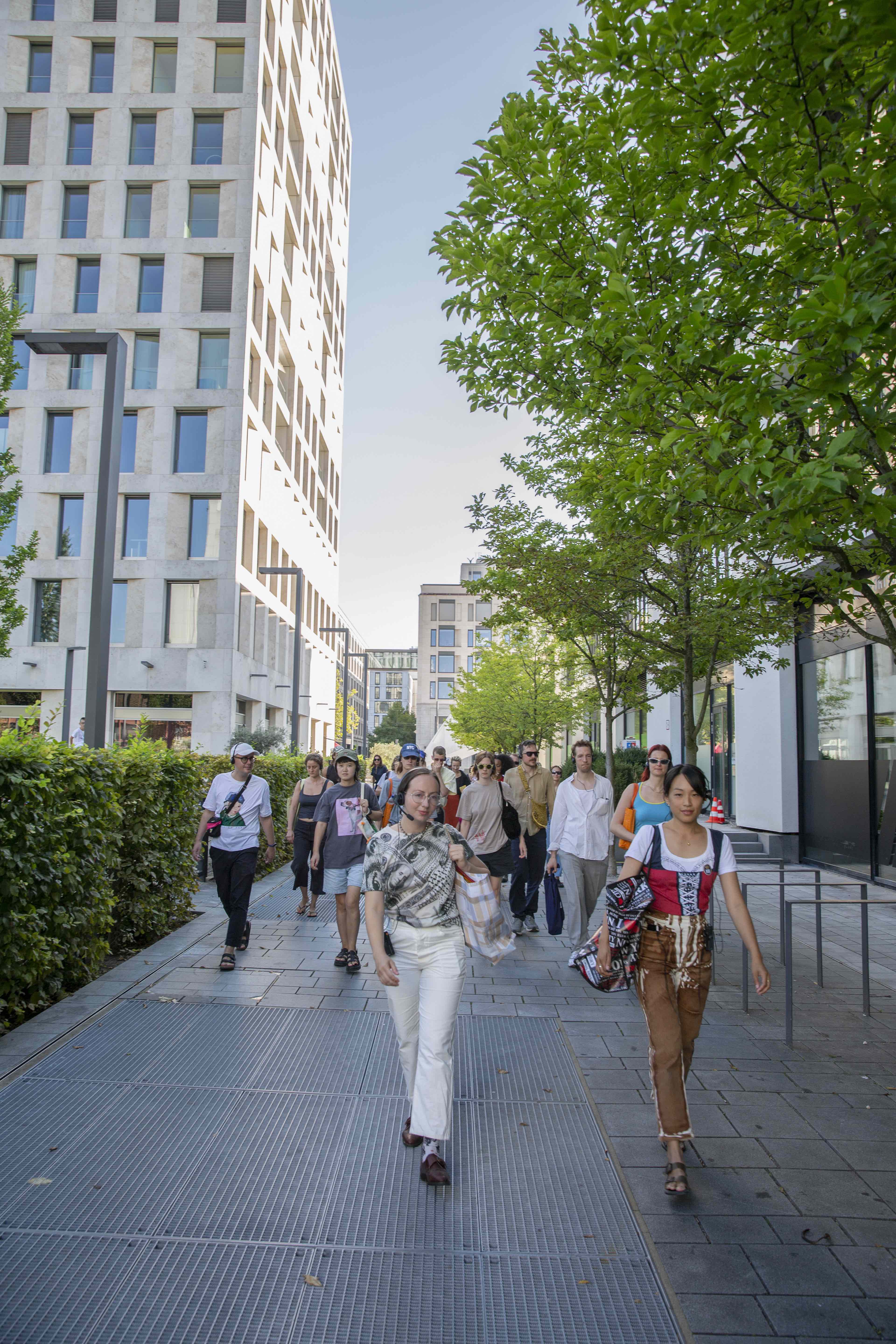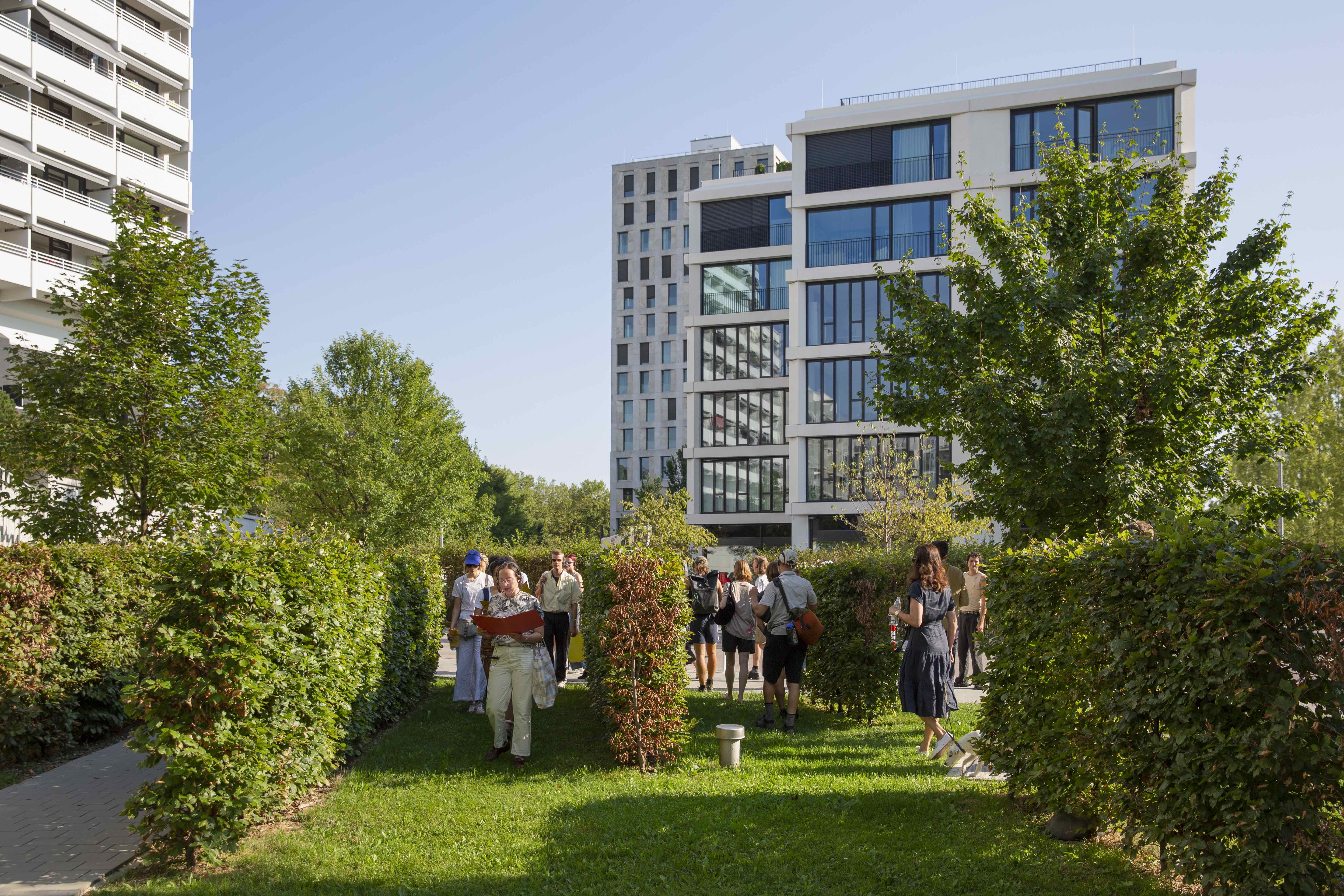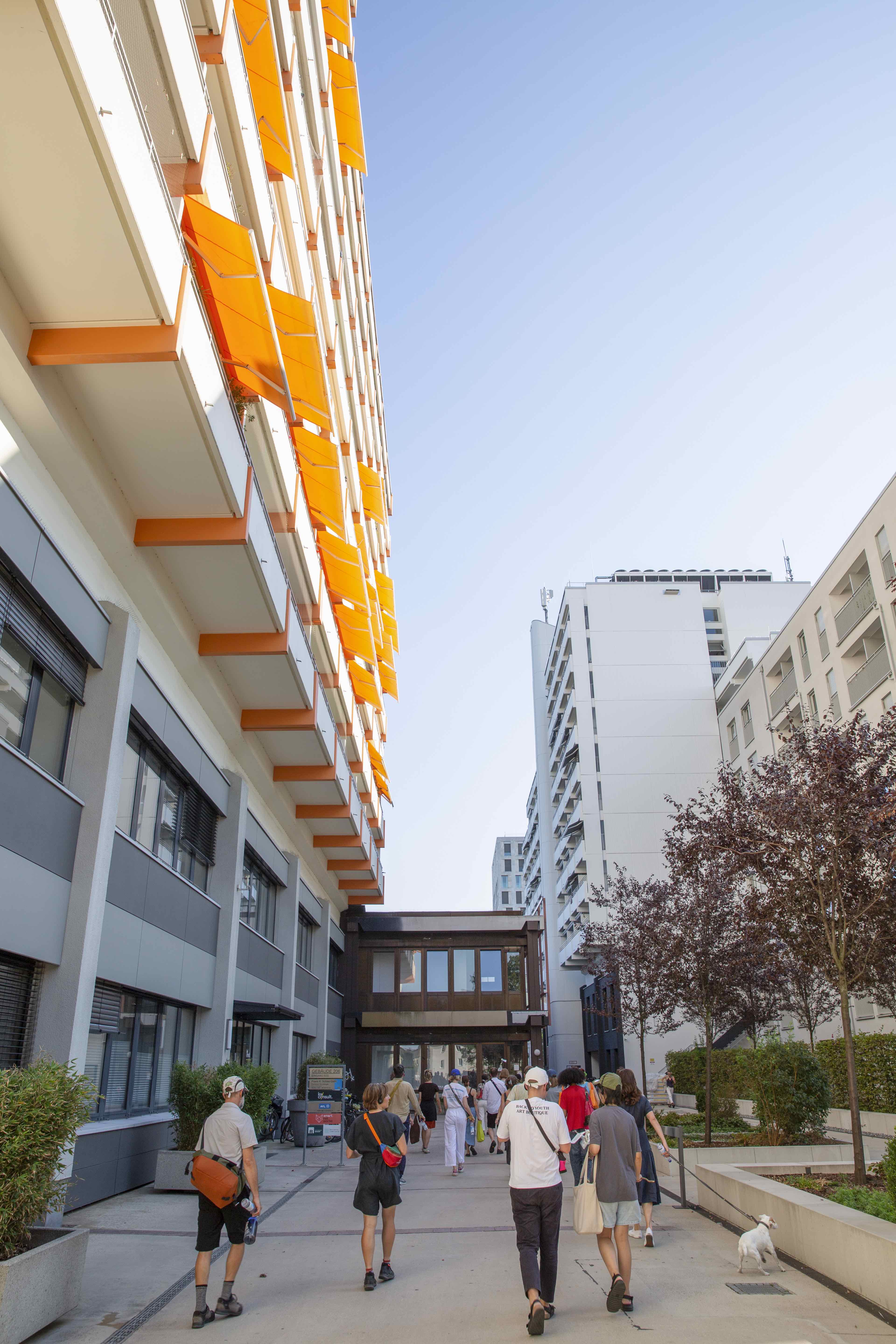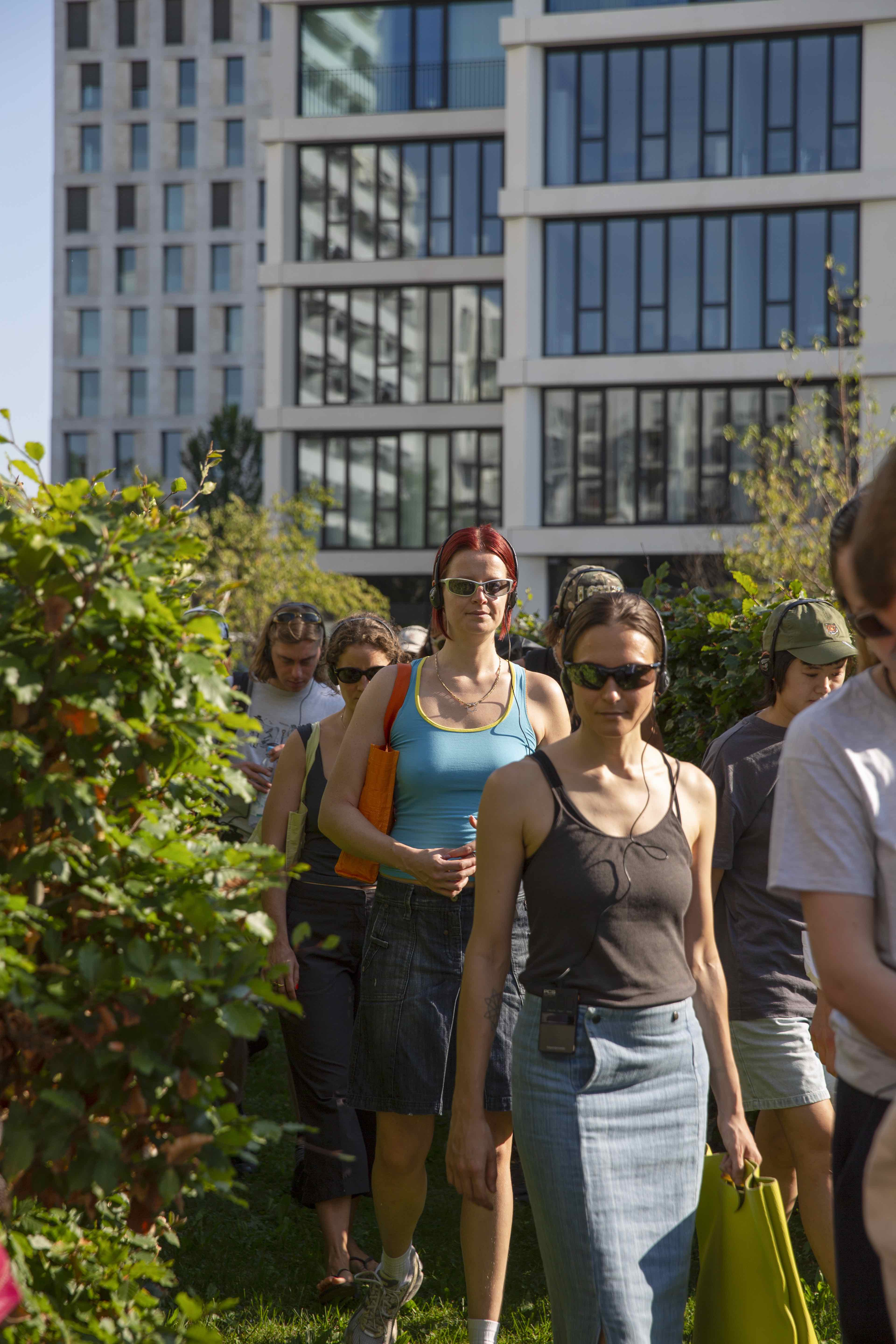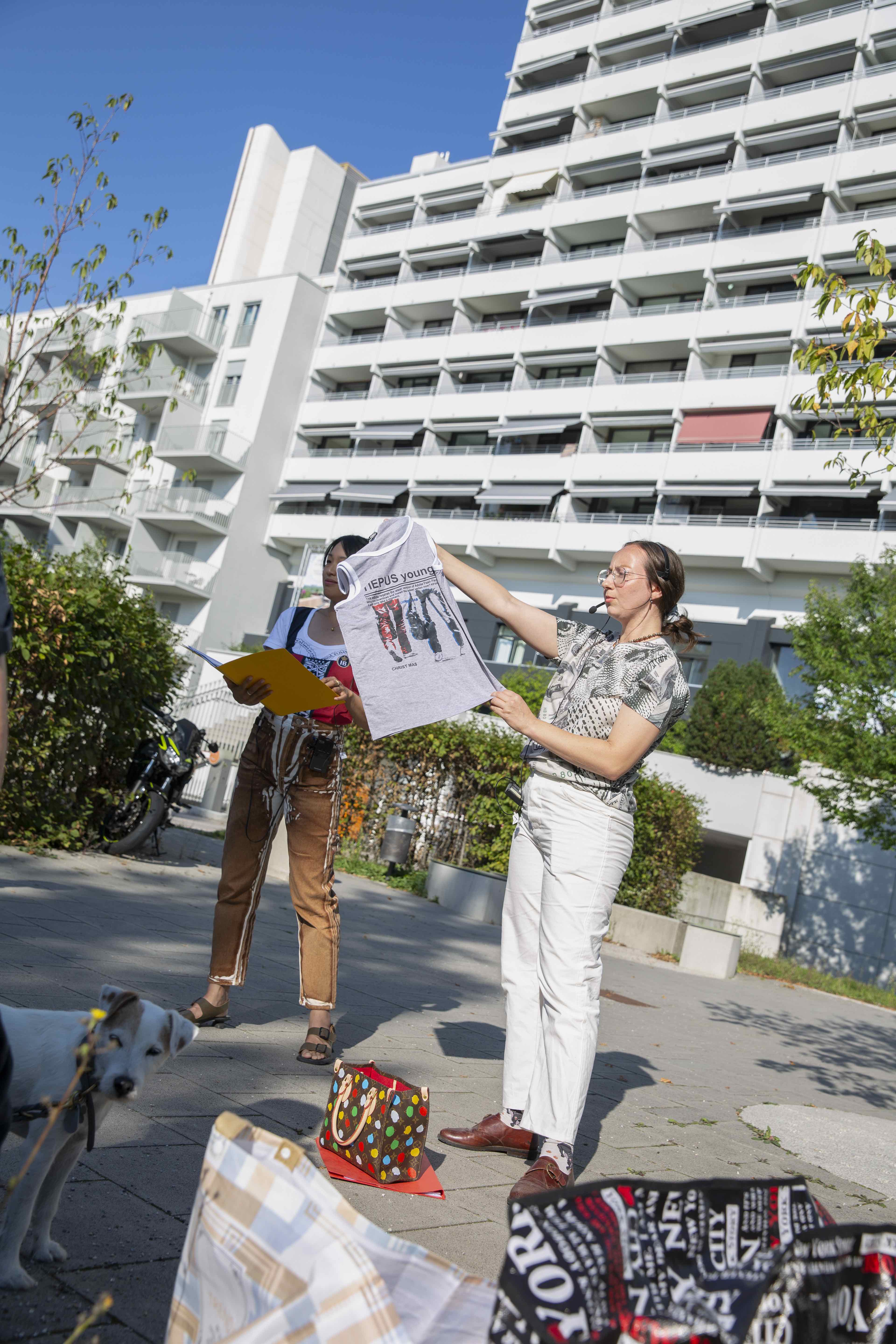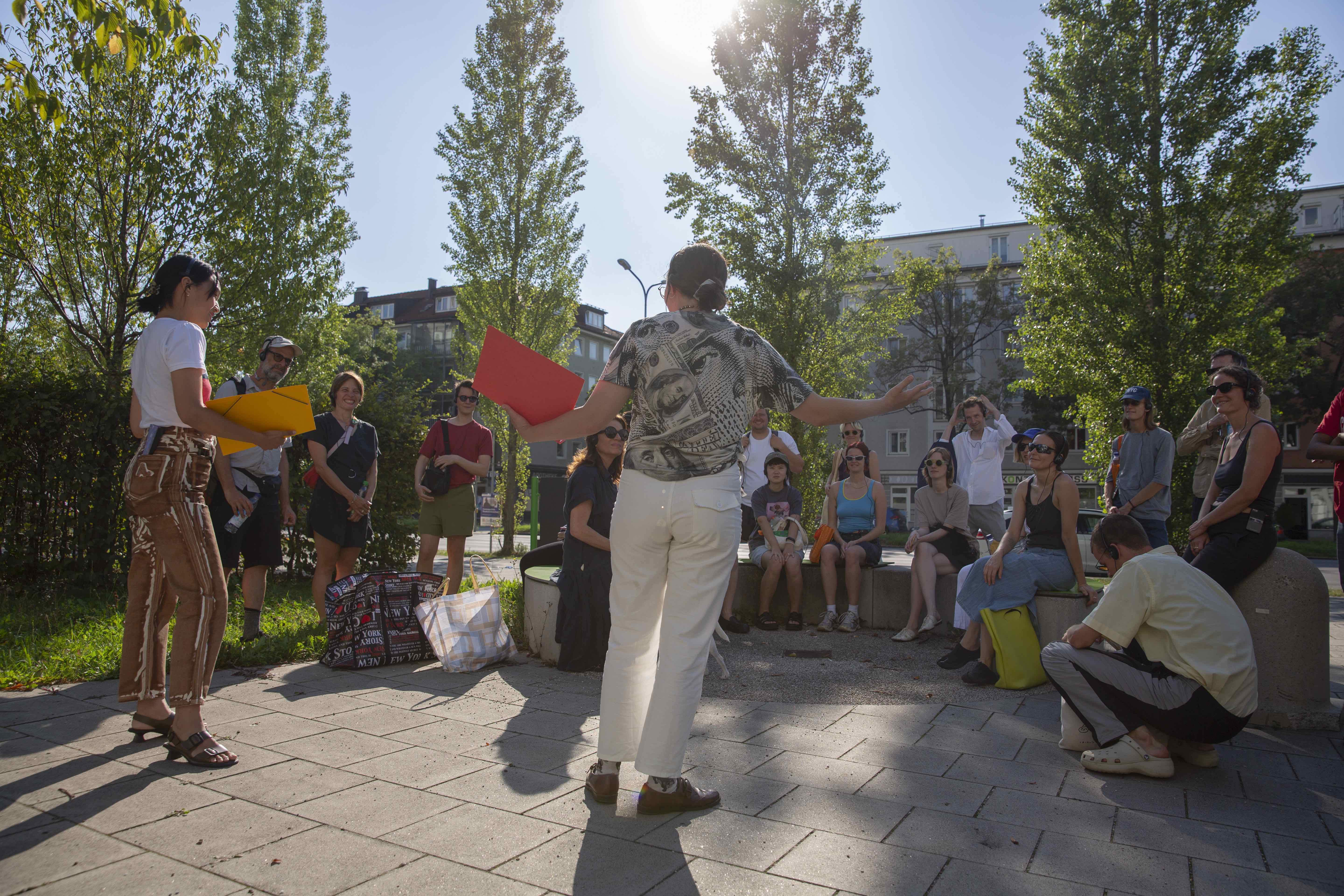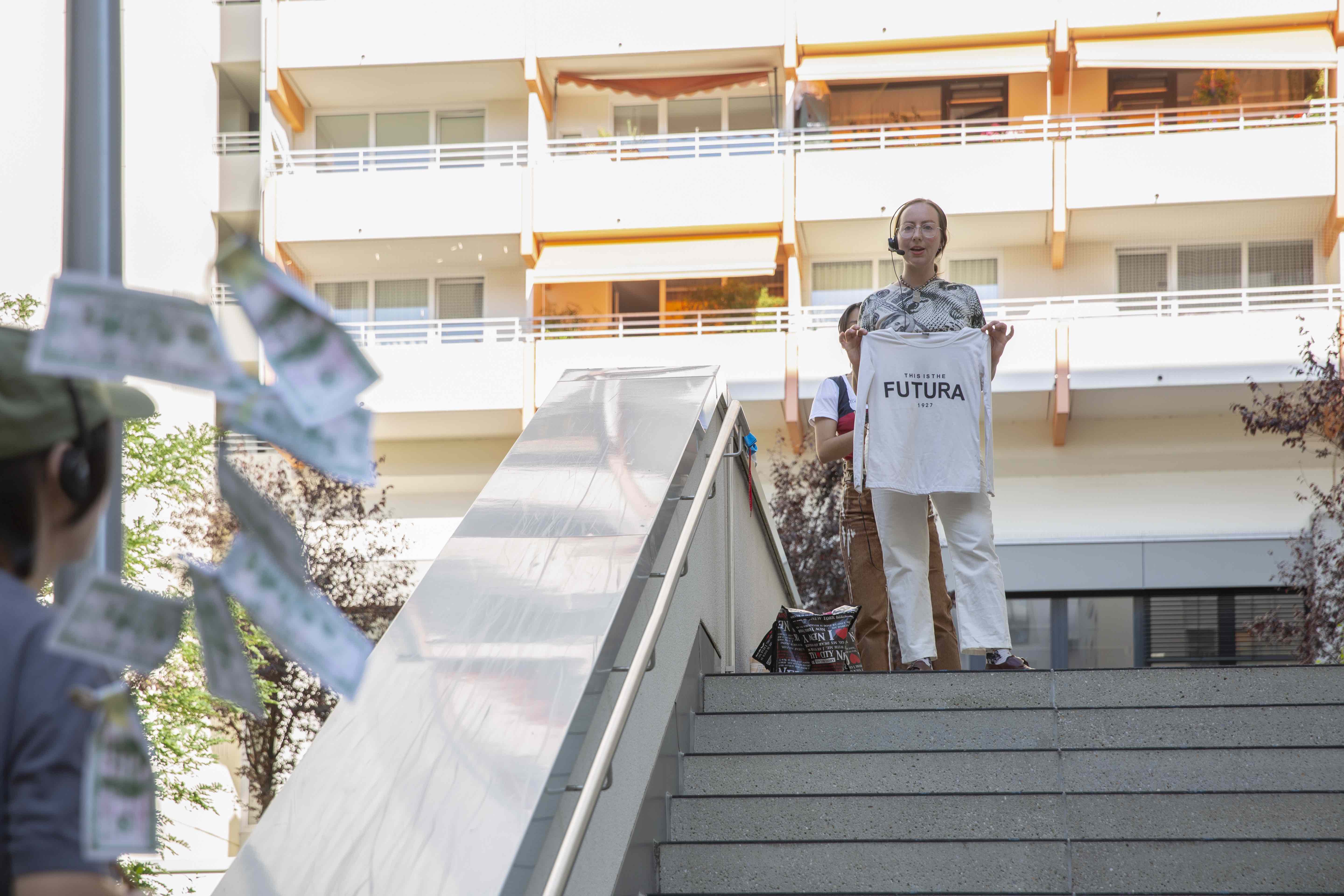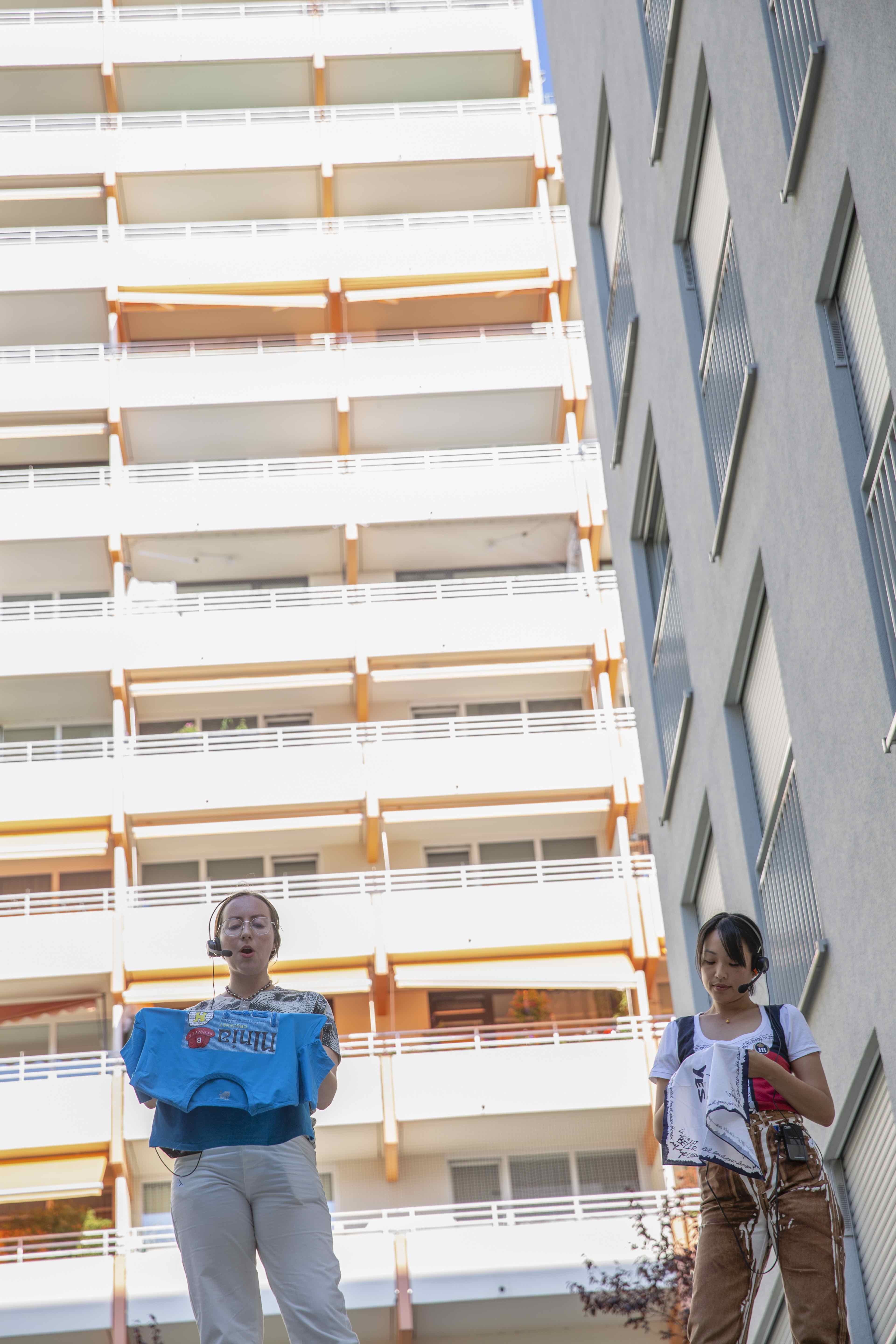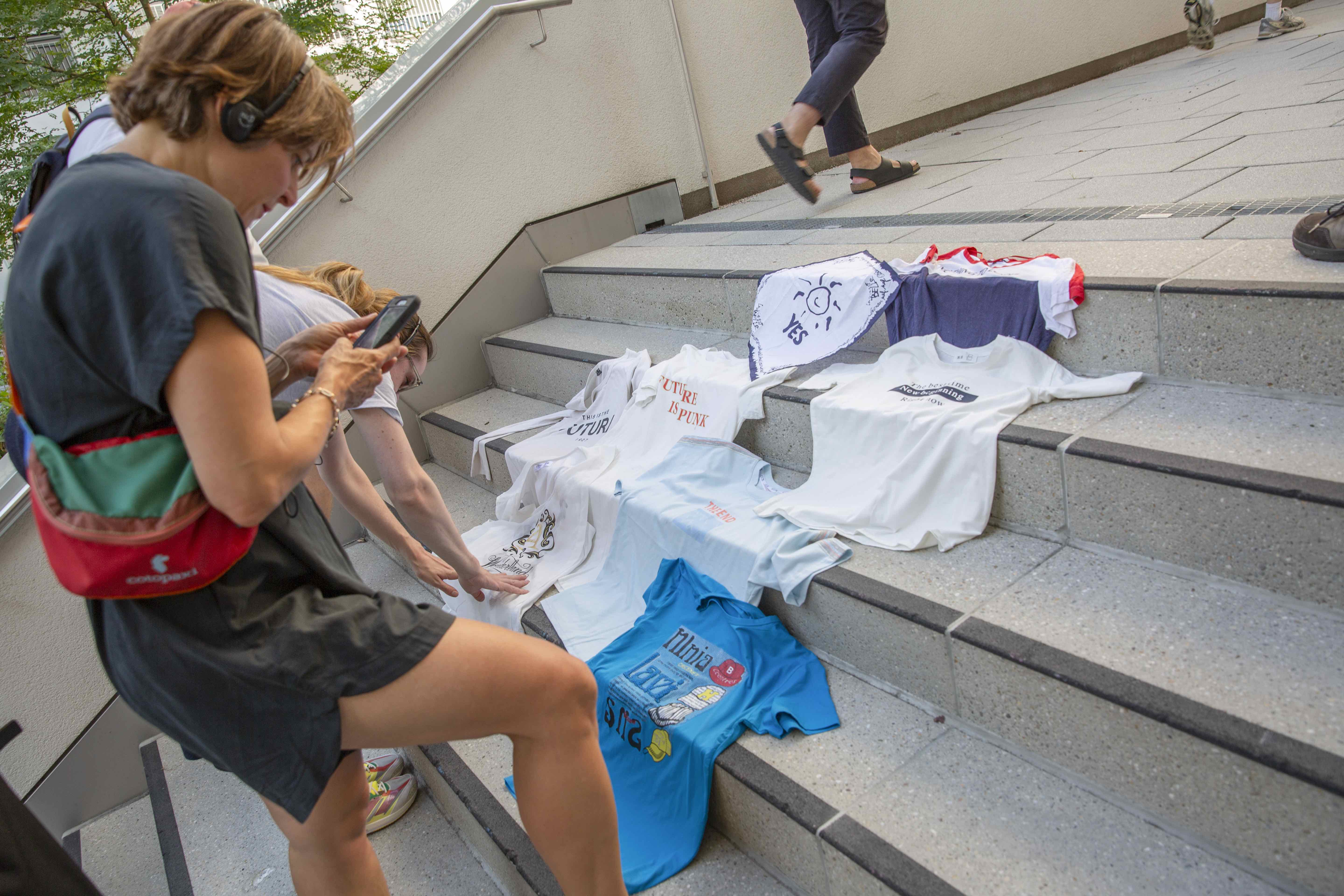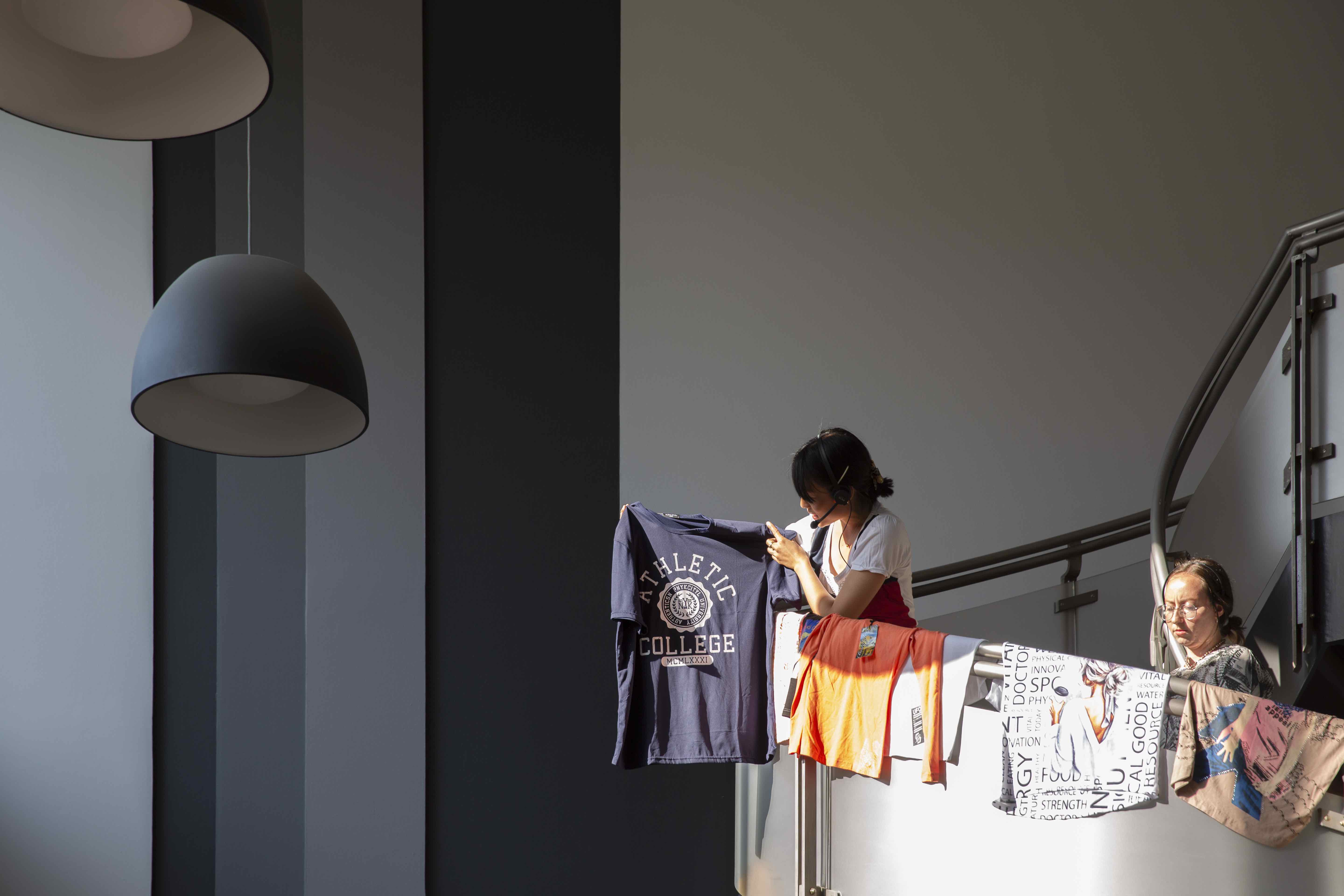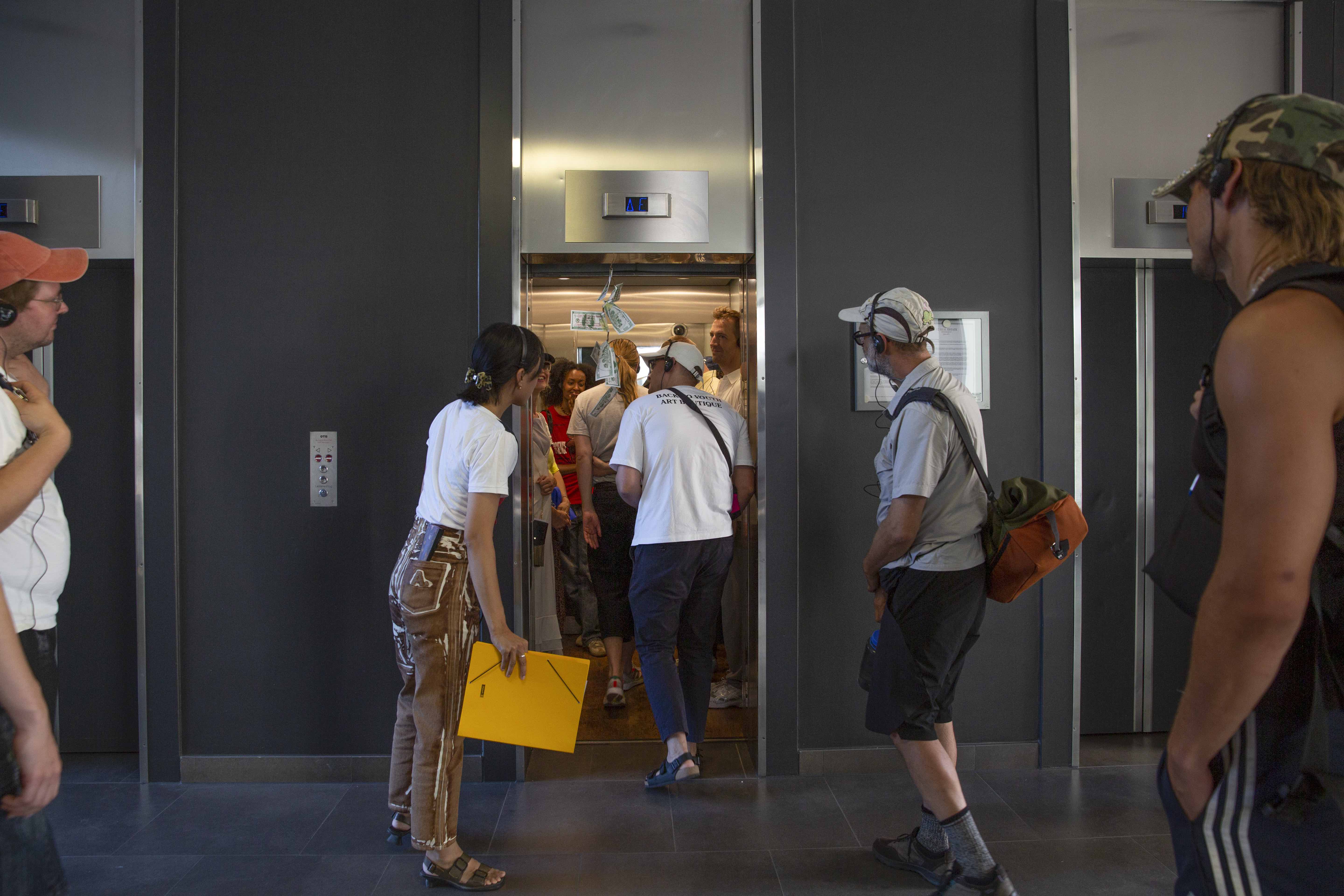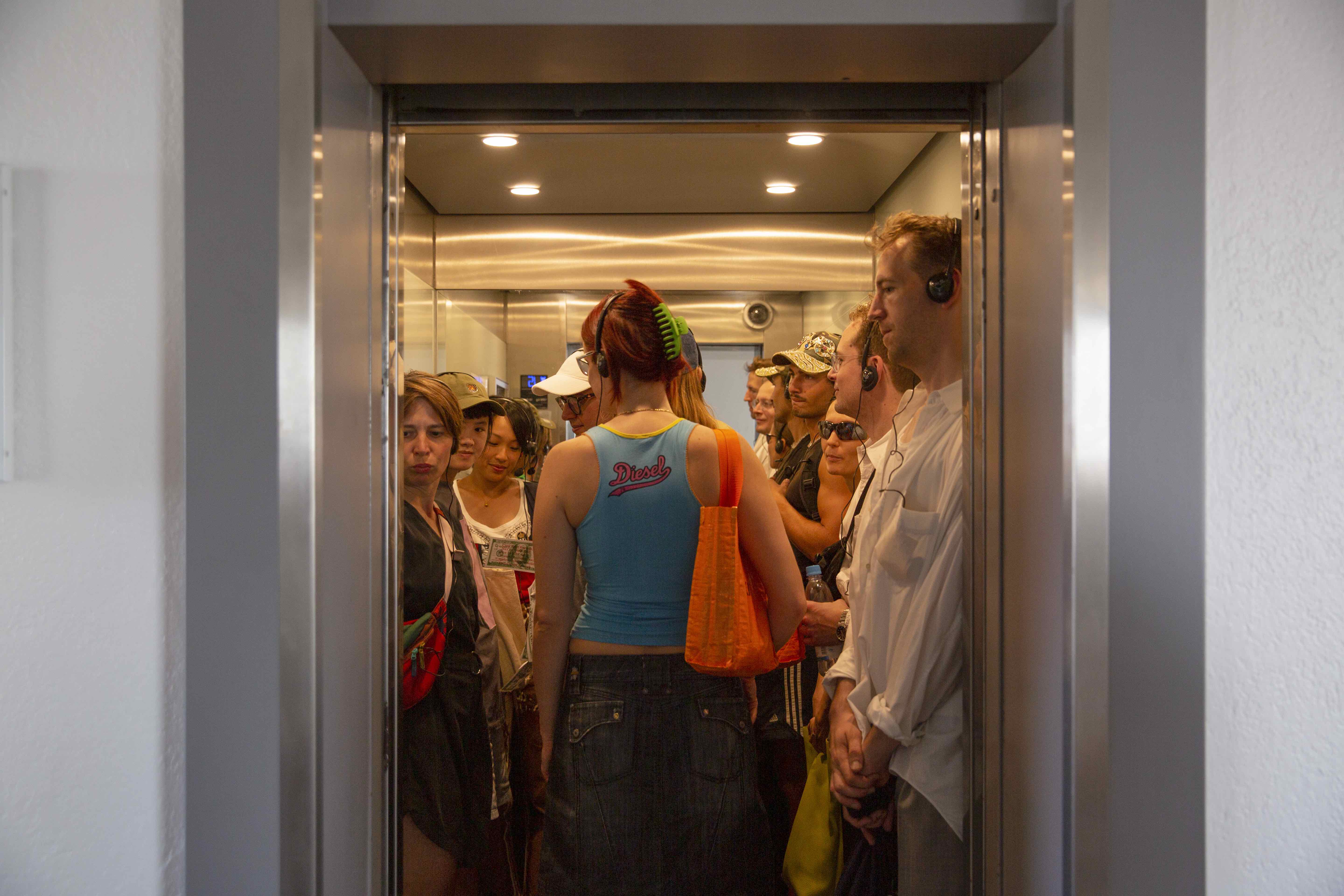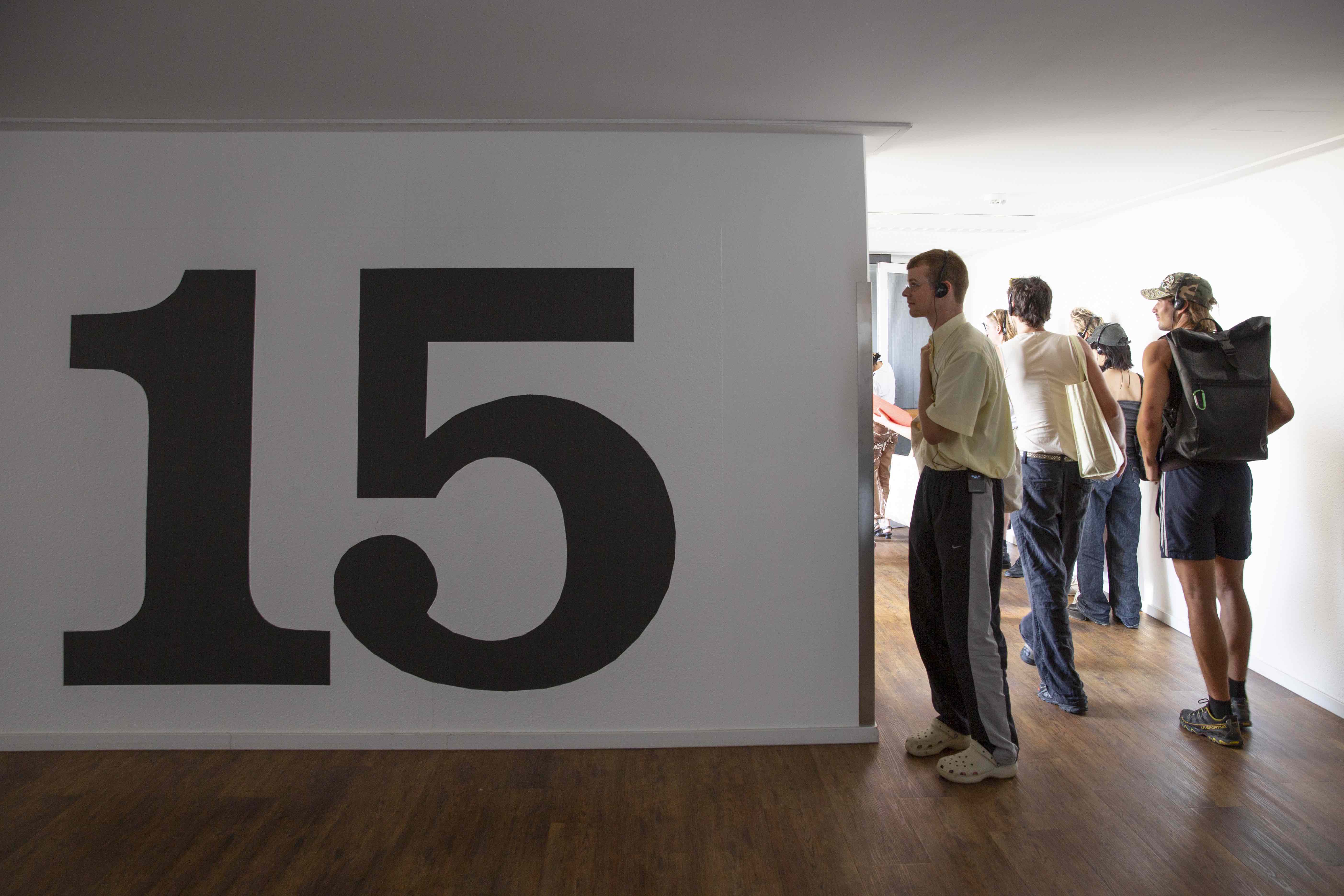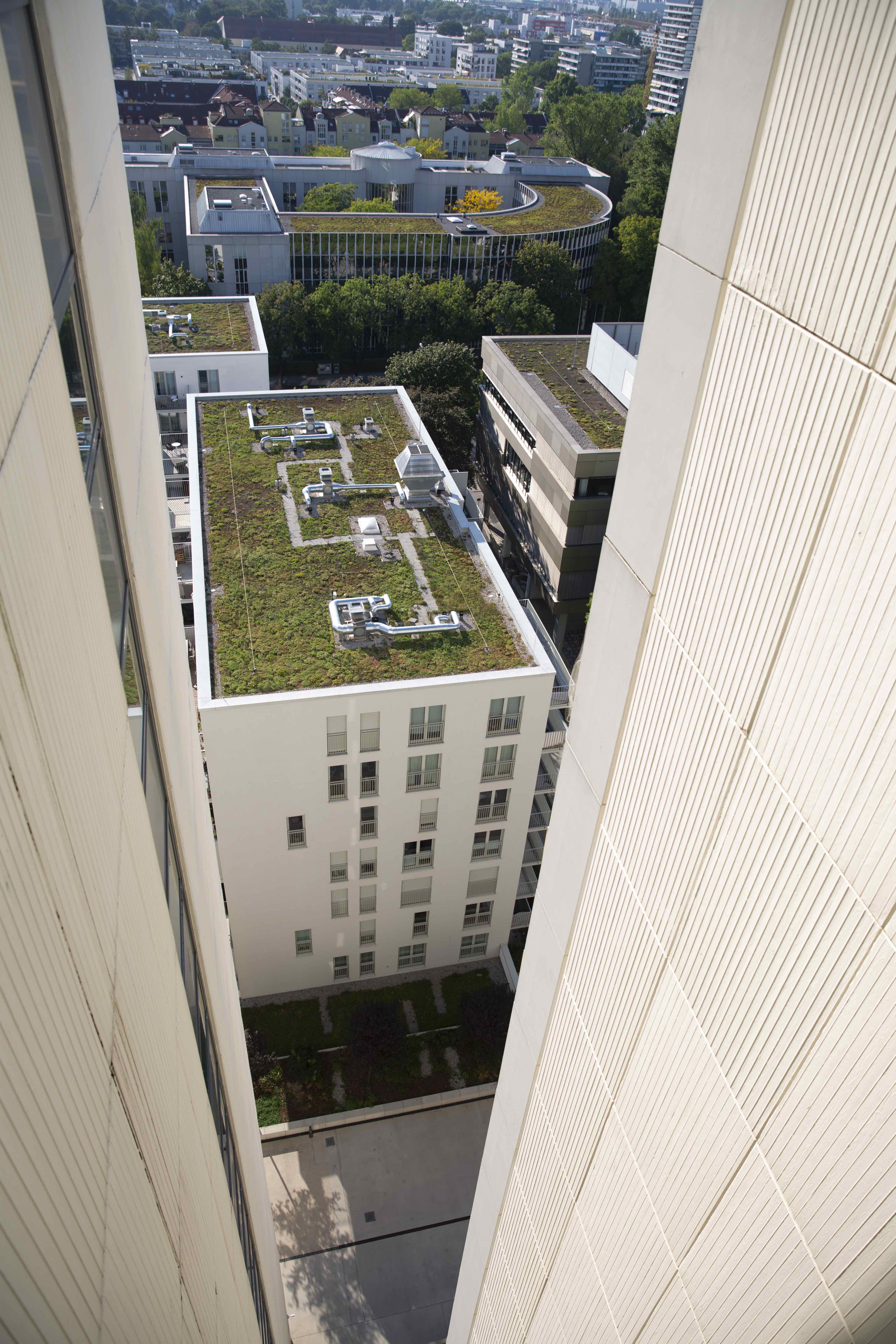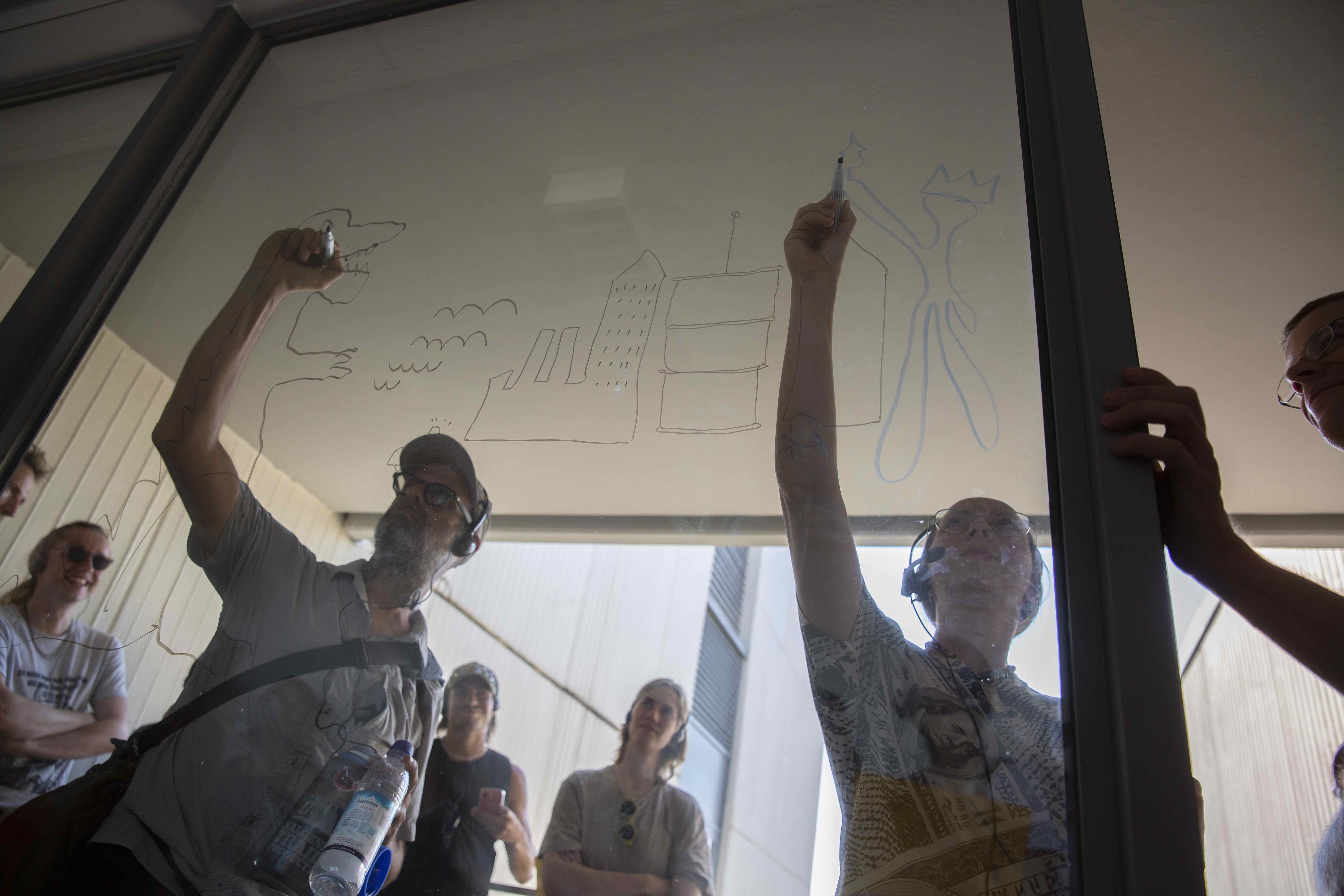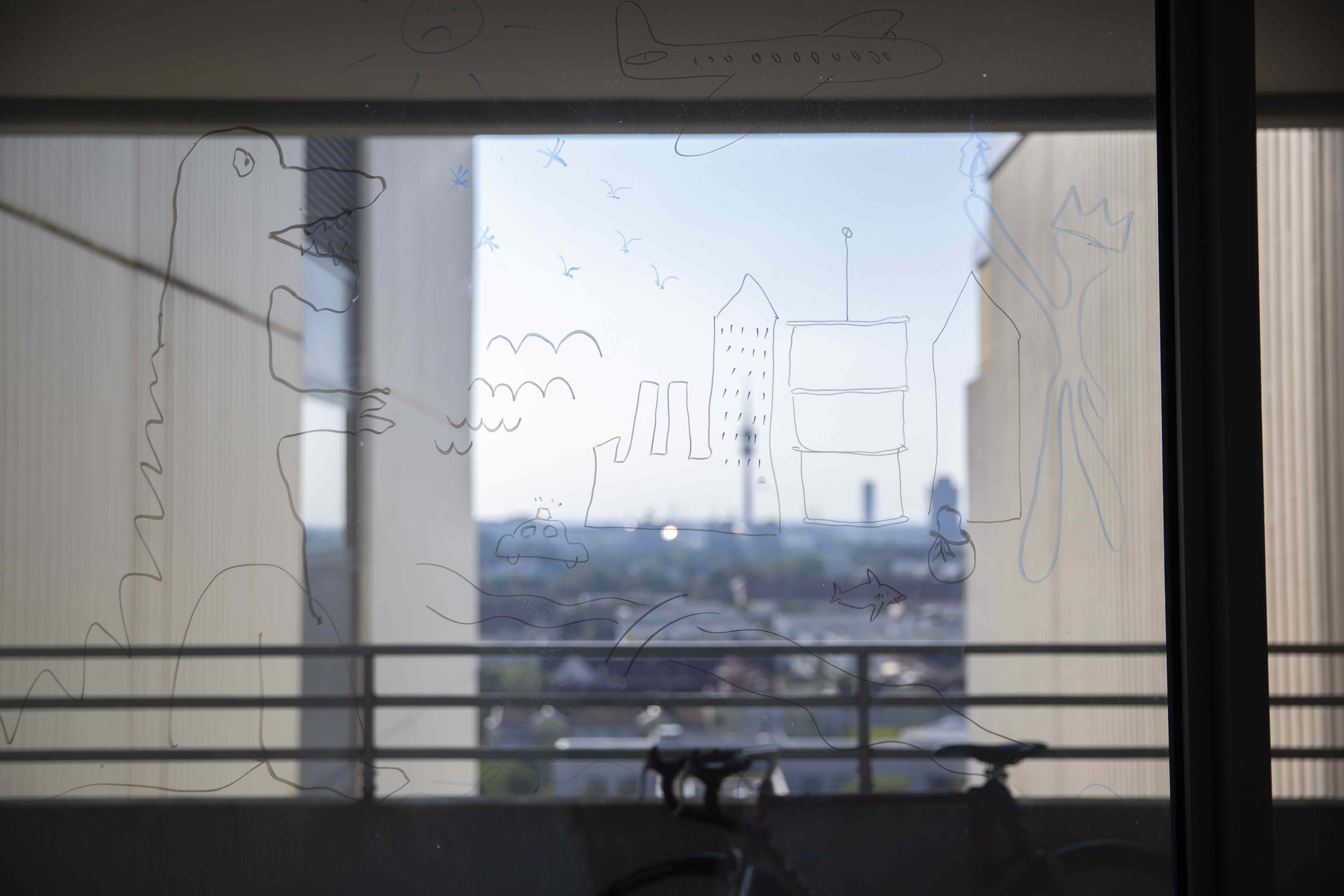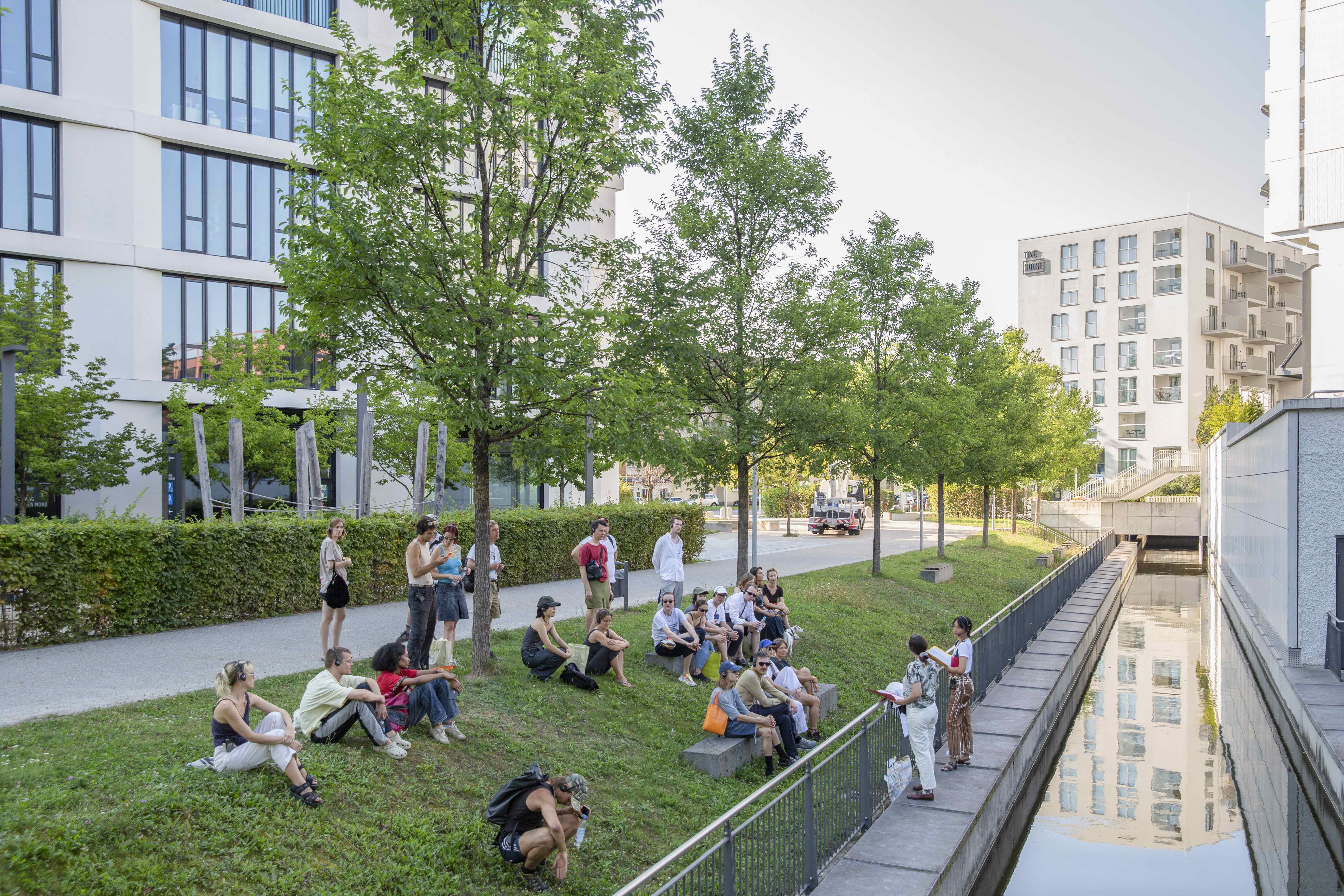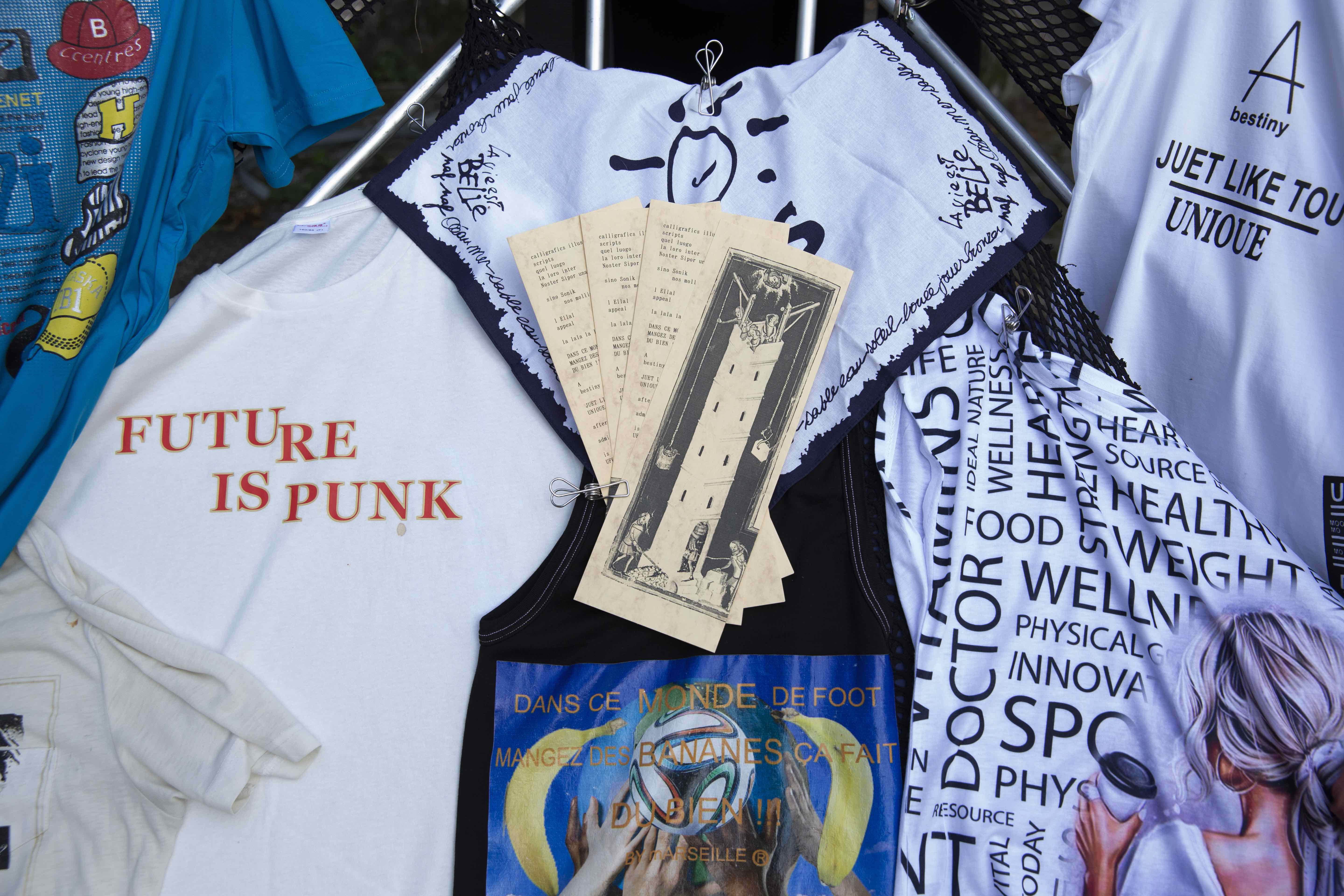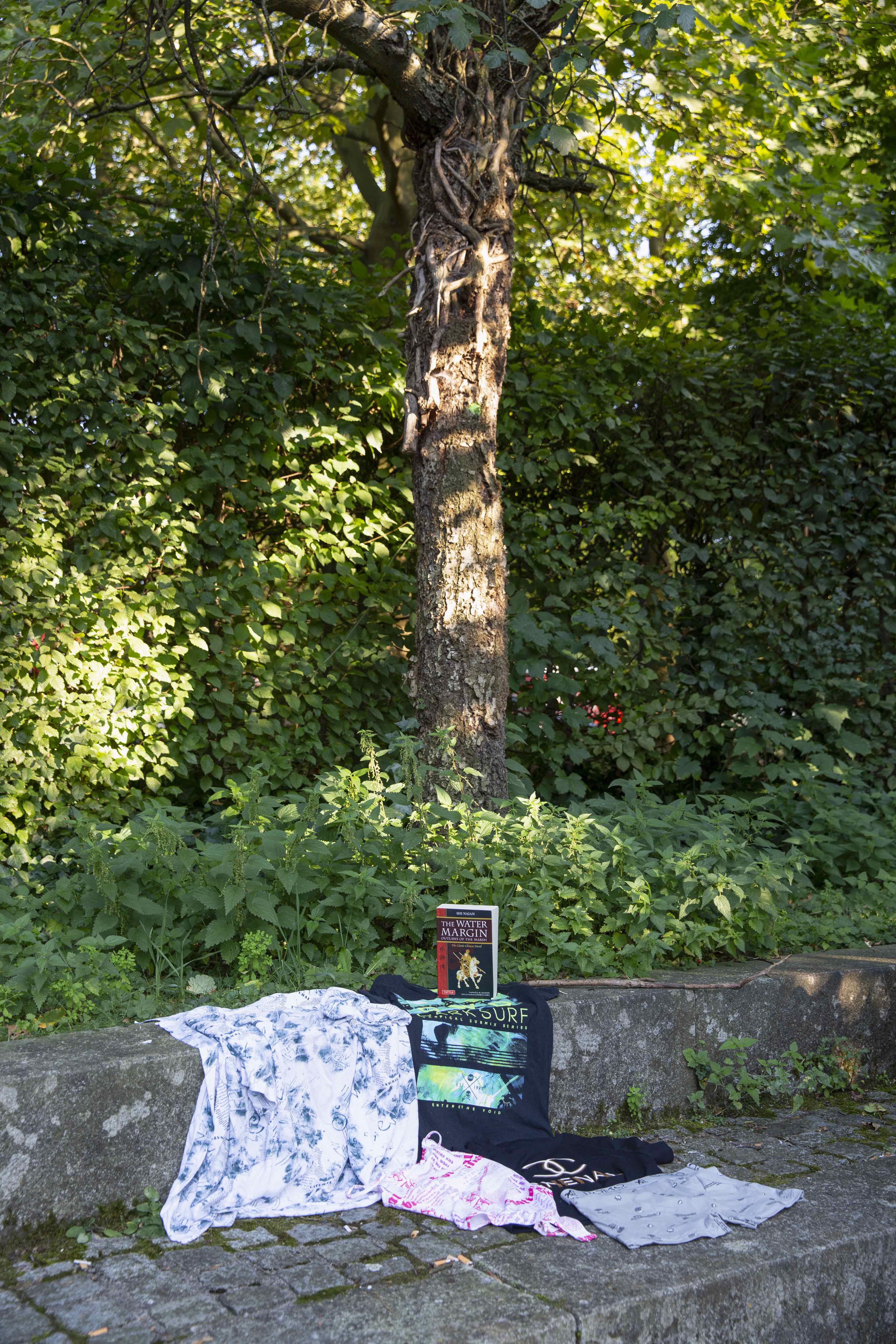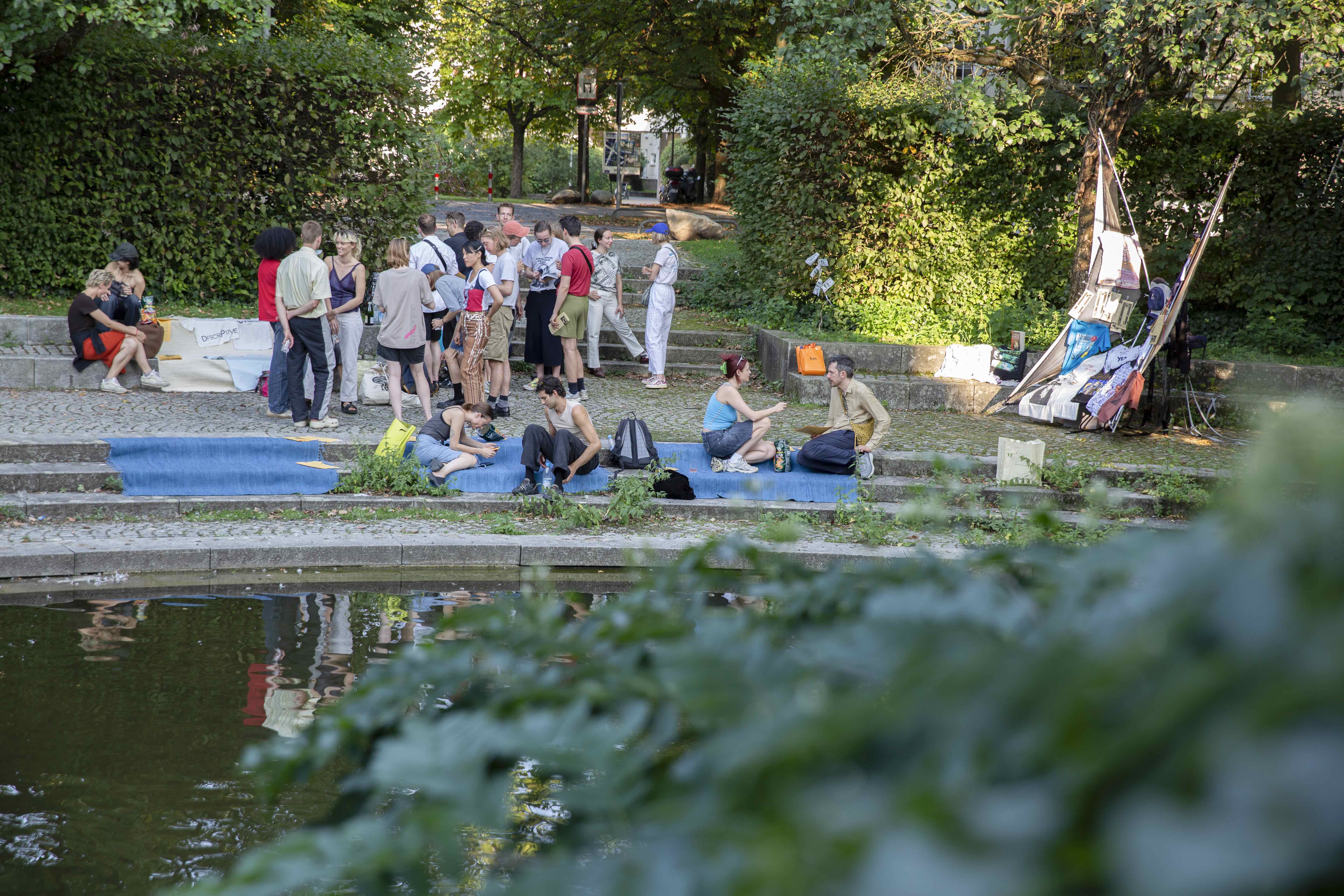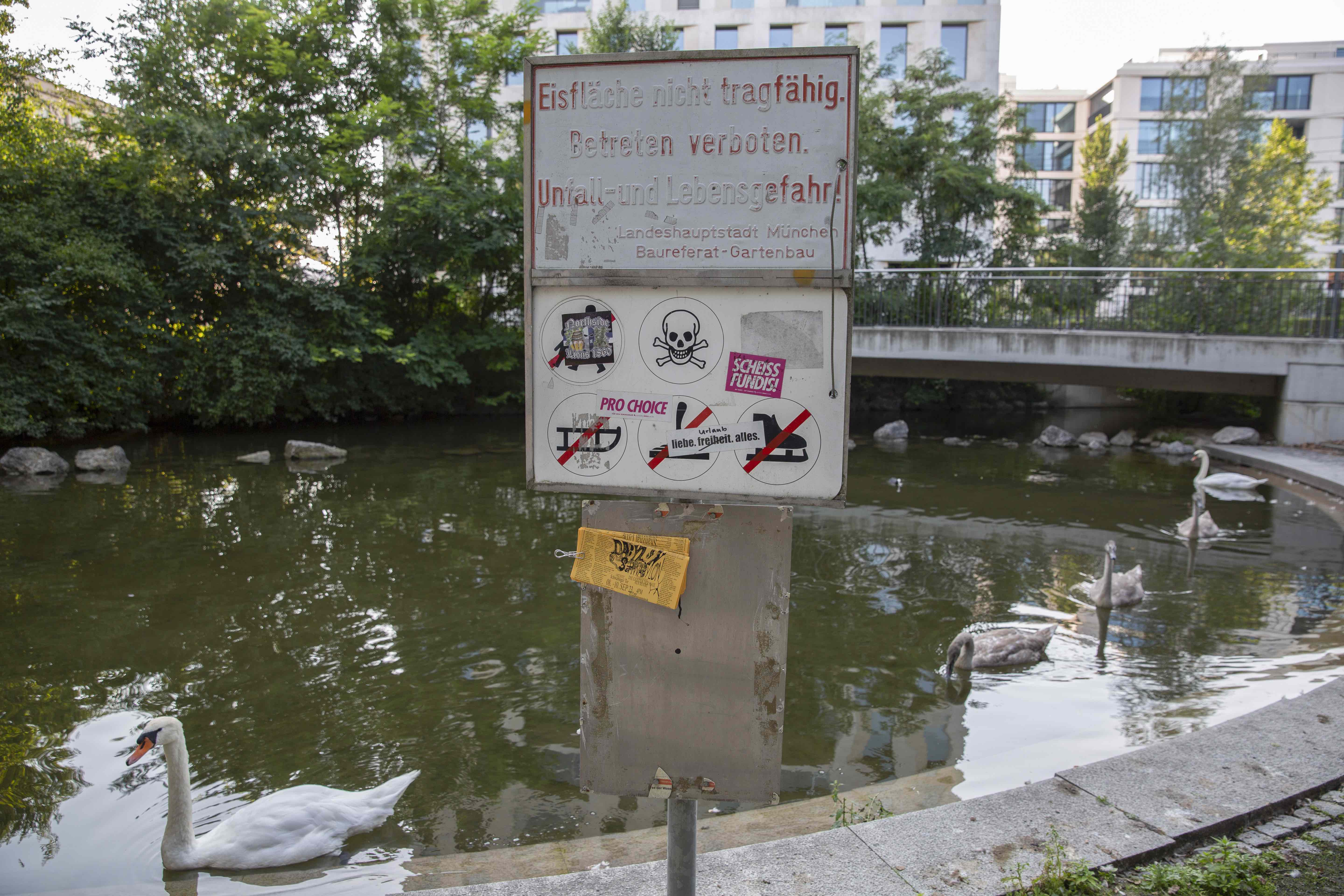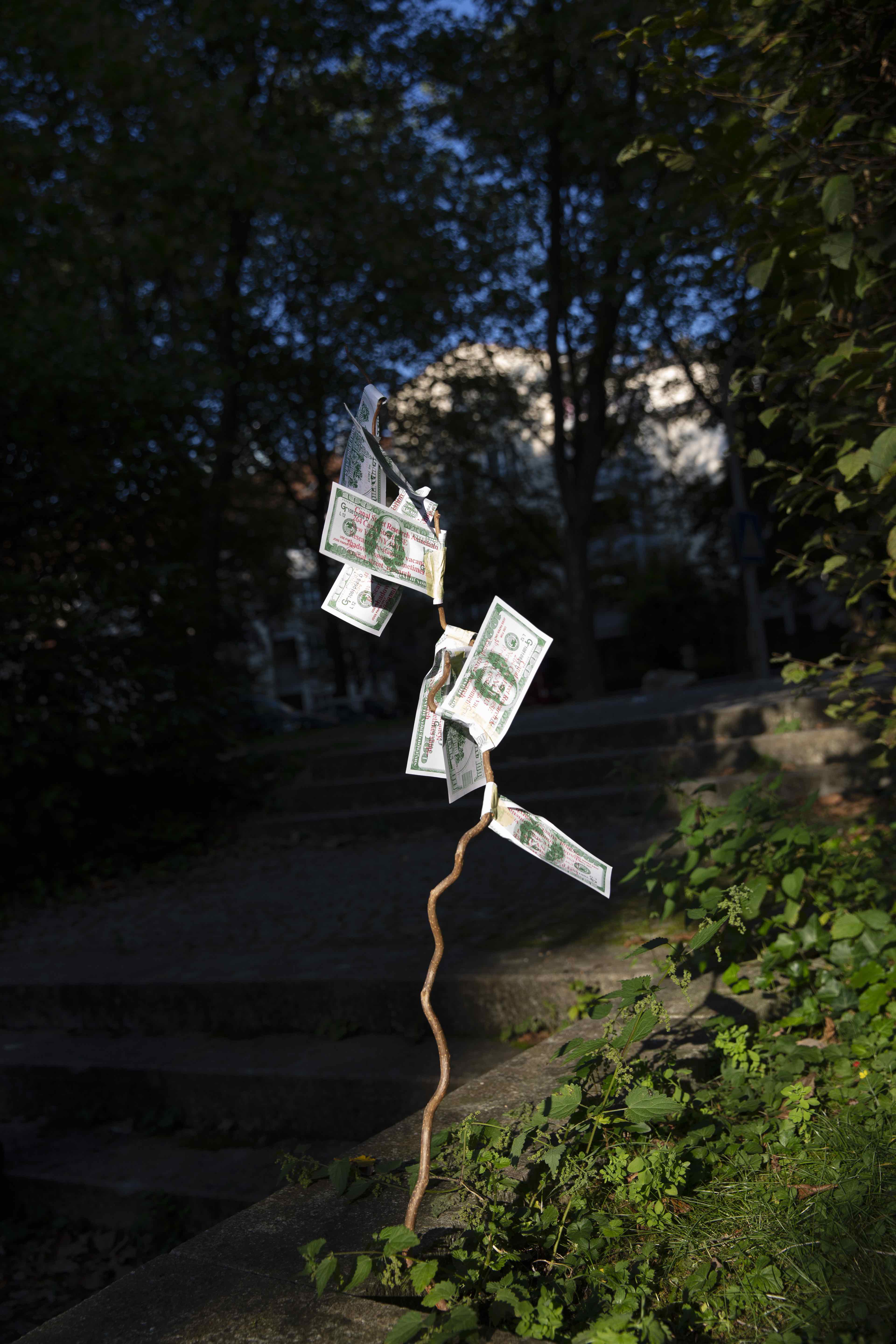DE
Frühsommer 2022. Die Sonne ist bereits sehr warm, ich folge meine*r Freund*in Kris1 in ein Gebäude an der Canal Street in Tribeca. Wir steigen in den Aufzug und fahren hoch. Die Tür öffnet sich direkt in eines dieser langgezogenen Lofts in einem ehemaligen Lagerhaus. Im vorderen Teil ist eine Art Shop aufgebaut, kleine Objekte auf einer Papptreppe am Fenster. Darunter blauweißgoldene Papp-Kaffeebecher, wie sie überall in New York zu finden sind, bei den Deliwägen zum Beispiel. Nur hier sind die Becher kleiner, eher Espresso-Größe, mit blauen griechischen Ornamenten, und statt dem goldenen Schriftzug „We’re happy to serve you“ steht dort „Pecunia Non Olet“ (Geld stinkt nicht).
Daneben eine aus Papier gefaltete Rose, eine Austernschale mit einer Kerze darin, eine Teekanne, eingepackte Geschenke, eine Publikation mit dem Titel Guide to the Wastelands of Flushing River. Queens, New York und vieles mehr, an das ich mich nicht erinnere. Weiter hinten eine Küche mit großem Papptisch, dann Papp-Paravants, dahinter zwei Betten. Ming und Alex nutzen das Loft als temporären Wohnort und als Basis für ihr fiktionales Büro Canal Street Research Association, das aus ihrer kollaborativen Praxis als Shanzhai Lyric entstanden ist.
Ming macht sich gerade was zu essen, bringt uns Wasser mit Eiswürfeln gegen die Hitze, und gibt mir eine Einführung. Sie erzählt, wie sie begannen, mithilfe des Arbeitslosengeldes, das sie 2020 von der Stadt als Corona-Hilfe bekamen, zur Canal Street zu recherchieren. Als Basis hatten sie zunächst ein kleines Ladenlokal auf Straßenniveau, das sie nutzten, um persönliche Erinnerungen von Bewohner*innen der Canal Street, historische Ereignisse oder künstlerische Arbeiten, die mit der Straße zusammenhängen, zu sammeln. Ich bin ziemlich beeindruckt davon, wie Ming spricht und ihre Arbeit vermittelt, wie ihre und Alex’ Recherche oft bei kleinen, vielleicht übersehenen Objekten beginnt und dann tiefer in die damit verbundenen Geschichte und Politik dringt. Und wie sie das wiederum in künstlerische Formen umwandeln. Sie erzählt etwa, dass sie den kleinen Pappbecher ursprünglich für das Museumscafé im PS1 in Queens angefertigt hatten. Wenn man dort Money Has No Smell bestellte, bekam man einen gewürzten senegalesischen Kaffee in eben diesem Becher serviert. Café Touba ist ein Getränk, das von westafrikanischen Straßenhändlern entlang der Canal Street angeboten wird. Mit dieser Arbeit zollen Shanzhai einerseits diesen Straßenhändler*innen Tribut, andererseits kommentieren sie den kapitalistischen Kunstbetrieb, in dem sie selbst auch verortet sind, auf eine, wie ich finde, sehr kluge und humorvolle Weise.2
Neben der Recherchetätigkeit und künstlerischen Arbeit ist es ihnen wichtig, die lokale Community einzubinden, ihre Ressourcen zu teilen, sei es Raum oder Wissen. Über die Zeit fanden in ihren Räumen Performances, Screenings und Modenschauen statt. Eine Trommelgruppe nutzt den Raum zum Proben, Ausstellungen fanden statt und so weiter. Es ist umso beeindruckender, dass sie für die drei Monate, in denen sie das Loft hatten, den Raum so offen und zugänglich wie möglich hielten, obwohl es gleichzeitig auch ihr privater Wohnraum war.3
Ming erzählt schließlich von Shanzhai Lyric. „Shanzhai“ ist ein chinesisches Wort und bedeutet „Fälschung“ bzw. direkt übersetzt „Bergdorf“. Der Begriff bezieht sich auf Gebiete am Stadtrand, in denen, außerhalb des Blicks der Regierung, „Banditen Waren horten, um sie unter den Menschen zu verteilen.“4 Das Projekt entstand, als Ming und Alex 2015 eine Residency in Beijing hatten und dort ihr gemeinsames Interesse für Ideen von Besitz und Eigentum, für kleinere Formen von Diebstahl und für die vielfältigen diasporische Nonsense-Sprachlandschaften vertieften. Die beiden waren in Beijing in einem migrantischen Arbeiter*innenviertel untergebracht, am Rande der Stadt. Von dort pendelten sie jeden Tag zu einem Markt für Frauenkleidung. Dort fanden sie viele T-Shirts mit Shanzhai Lyrics, wie sie zuerst die englisch-sprachigen collagierten oder falsch übersetzten Phrasen bezeichneten und später auch ihr gemeinsames Projekt. Als Shanzhai Lyric archivieren Ming und Alex mittlerweile hunderte dieser T-Shirts. Die Kleidungsstücke, die zumeist in China produziert und weltweit vertrieben werden, bilden zusammen ein endloses Gedicht, das von einem bestimmten Moment im globalen Kapitalismus erzählt. Bevor ich gehe, kaufe ich ihnen noch ihre eigene Version eines Shanzhai-T-Shirts ab. In goldenen Buchstaben steht das Wort CANAL drauf, in Chanel-Schrift mit den zwei ineinander verschlungenen Chanel- oder eben Canal-Cs drüber. Tatsächlich ist das das einzige Shanzhai-Shirt, dass sie selbst gemacht haben. Bei allen anderen handelt es sich um found poetry.
Ein paar Wochen später ist richtig Sommer, einer in dem auch die Nächte nicht mehr abkühlen. Ich fahre zur Ausstellungseröffnung im Rumpelstiltskin in Greenpoint, nicht weit weg vom East River. Der Ausstellungsraum ist in einem Art Bürogebäude gelegen, im Atelier zweier Künstler, die ihn auch betreiben, und auf dem Dach sollten Performances stattfinden. Der Vermieter hatte darauf aber dann keinen Bock und alles wird schnell nach unten auf den Parkplatz verlagert. Auftritt Alex. In einer hautfarbenen Ganzkörper-Strumpfhose mit aufgemalten roten Rauten und Puffärmeln, in roten Pumps und mit rotem Haarreif, beginnt sie ins Mikrophon zu sprechen. Zunächst recht zart, dann immer wilder, stöckelt, stolpert, krabbelt, wälzt sich, spreizt die Beine, immer mit Blick zum Publikum hin. Ich bin bisschen schüchtern und halte mich im Hintergrund. MY COUNTRY MY COUNTRY MY CUUUNNNNT RYYY MY CUUNT RYYY. Es ist der 4. Juli, der US-amerikanische Nationalfeiertag. Es ist schon ziemlich lustig und absurd und tragisch, auch. Und dann beginnt das Macy's Fourth of July-Feuerwerk und ein Großteil des Publikums bewegt sich Richtung Ufer, fort von Alex’ Performance. Alex hält dagegen. LOOK AT ME – LOOK AT ME!! I WORK HARDER! I WORK HARDER!! LOOK AT ME!! Die Feuerwerke schießen weiter in den Himmel, Alex zappelt und brüllt jetzt. Im Grande Finale springt sie in eine der großen Mülltonnen, biegt sich durch und hängt kopfüber über den Tonnenrand, haut die Deckel auf und zu, auf und zu, auf und zu. Ende. Ich bin Fan. So lernte ich dann auch Alex kennen.
Ich freue mich also sehr, diese beiden für Ruine Companions hier in München zu haben. Shanzhai Lyric nehmen uns mit auf einen performativen Stadtrundgang durch Landschaften der Vielsprachigkeit und des Nonsens vor dem Hintergrund des neuen Münchner Nobelviertels Schwabinger Tor – direkt neben dem ehemaligen Standort des avantgardistischen Einkaufs- und Freizeitzentrums Schwabylon. Der Spaziergang verwebt dabei Shanzhai Lyrics vorherige Recherchen zur Poetik der Fälschung und zu Diebstahl als eine Form der Umverteilung mit der Geschichte des Stadtviertels als vergangene Vision einer postmodernen Utopie.
(Ruine München, September 2023)
Link zum Companion-Text:
Die Geister der Haie aus Miami / The Ghosts of the Sharks from Miami
1 Künstler*in und Freund*in Kristina Schmidt. Kris kannte Ming und Alex und deren Arbeit schon länger zu der Zeit, und es war auch Kris’ Vorschlag, sie an dem Tag zu besuchen. DANKE!
2 Auf ihrem Instagram-Account @canal_street_research können viele ihrer Recherchen nachgelesen werden.
3 Ming selbst ist dort in der Nähe aufgewachsen und ihre Eltern leben immer noch da. Sie selbst könnte sich heute dort keine Wohnung leisten. Alex ist im East Village aufgewachsen, auch nicht weit weg und mit ähnlichen Gentrifizierungsproblemen. Das Loft hingegen befindet sich in einem Bürogebäude, das aufgrund von Covid fast komplett leer stand. Aufgrund einer Abmachung mit dem Hausverwalter konnten sie dort semilegal wohnen. Das letzte Jahr über hatten Shanzhai Lyric einen kleinen Raum im Keller unter einem der alten, mit runden Glasfliesen durchbrochenen Gehsteige an der Canal Street, wo ich sie dann im Winter nochmal besuchen konnte. Vor kurzem sind sie in ein altes Schulgebäude etwas weiter im Osten gezogen.
4 https://www.servinglibrary.org/journal/17/pecunia-non-olet [Zugriff 1.9.2023] Der Text im Pdf ist super.
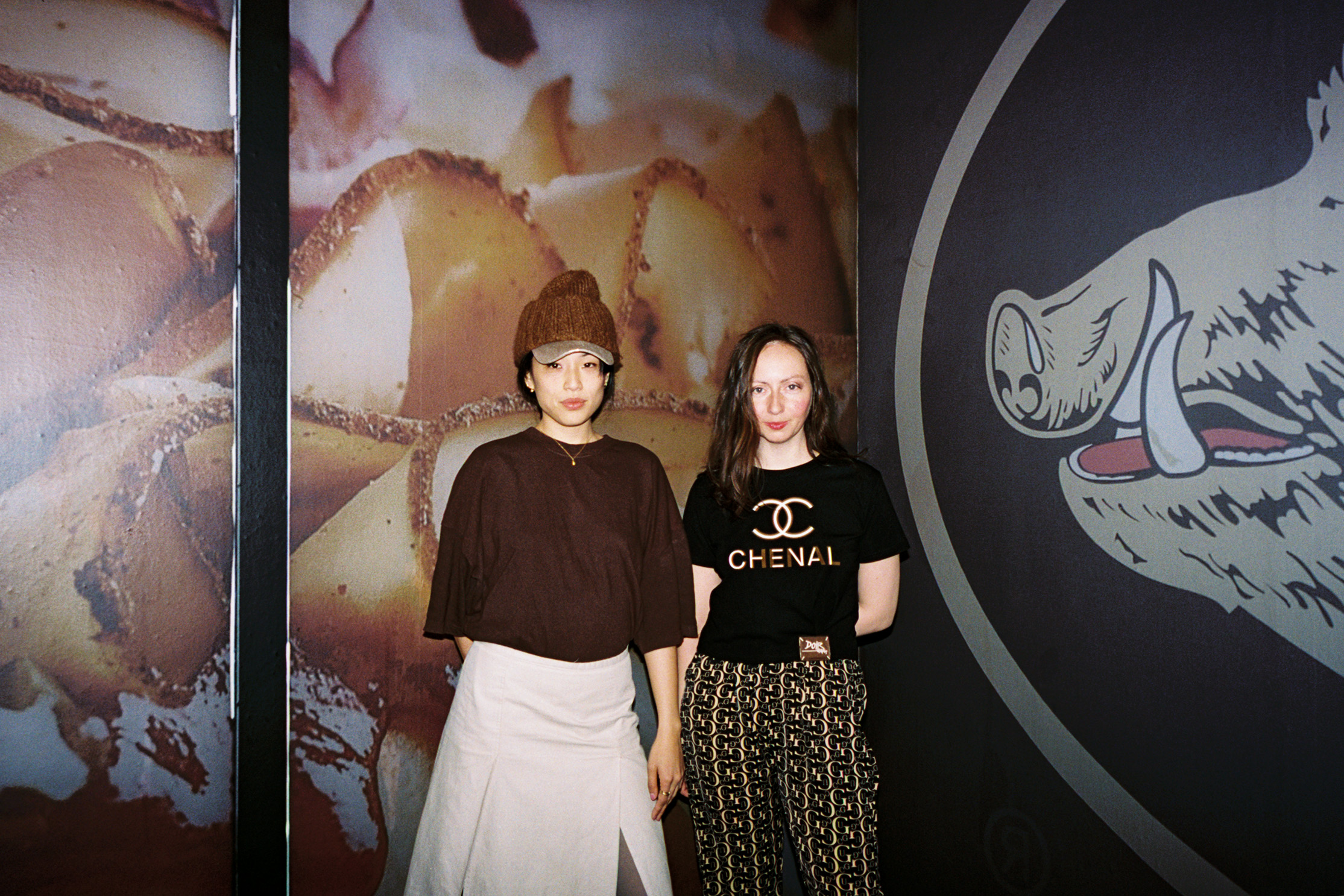
Shanzhai Lyric is a body of research focusing on radical logistics and linguistics through the prism of technological aberration and nonofficial cultures. The project takes inspiration from the experimental English of shanzhai t-shirts made in China and proliferating across the globe to examine how the language of counterfeit uses mimicry, hybridity, and permutation to both revel in and reveal the artifice of global hierarchies. Shanzhai Lyric circulate their ever-growing archive of poetry-garments in the form of poetry-lecture, publication, and installation. In the fall of 2020, Shanzhai Lyric founded the fictional office entity Canal Street Research Association from which they continue to problematize notions of ownership and property through bootleg as method. Their work has been presented in unofficial and official spaces including Amant, Times Museum, INIVA/Stuart Hall Library, Women’s Art Library, Abrons Arts Center, SculptureCenter, Artists Space, MoMA PS1, Printed Matter, Harvard (AFVS), Clearview Ltd, and the Canadian Centre for Architecture. Selected publications include essays in The New Inquiry, Viscose, The Serving Library, Capilano Review, Vulture and ArtReview Asia.
https://shanzhailyric.info/
https://www.instagram.com/shanzhai_lyric/
https://www.instagram.com/canal_street_research/

EN
It’s early summer 2022, the sun is already very warm and I’m following my friend Kris1 to a building on Canal Street in Tribeca. We get into the elevator and go up. The door opens directly on to one of those long lofts in a former warehouse. A kind of store is set up at the front and there are small objects on a cardboard staircase by the window. Among them are blue and gold cardboard coffee cups similar to the ones you find all over New York, at deli carts, for instance. Only here the cups are smaller, more espresso-sized with blue Greek ornaments, and instead of the gold lettering “We’re happy to serve you”, it says “Pecunia Non Olet” (Money doesn’t stink). Next to it is a folded paper rose, an oyster shell with a candle in it, a teapot, wrapped gifts, a publication titled Guide to the Wastelands of Flushing River. Queens, New York and a lot of other things I don’t remember. Deeper in the room there’s a kitchen with a large cardboard table, some cardboard screens and behind those, two beds. The loft is a temporary home for Ming and Alex and the base for their joint work as the fictional office Canal Street Research Association, an outgrowth of their ongoing collaboration as Shanzhai Lyric.
Ming is making herself something to eat. She brings us water with ice to help with the heat and begins to give me an introduction. She tells me how they started researching Canal Street with the help of the unemployment benefits they received from the city in 2020 as a form of covid assistance. They started with a small storefront on street level which they used to collect personal memories from Canal Street residents, information on historical events, and artistic works about or relating to Canal Street. I quickly become quite impressed with how Ming speaks about their work, how their research often starts with small, perhaps overlooked subjects, and how they delve deeper into the history and politics associated with them. And how they then, in turn, produce an artistic contribution of their own. One example she talked about was the small coffee cup they made for PS1’s museum café in Queens. When you ordered the drink Money Has No Smell, you were served a spiced Senegalese coffee in that very cup. Café Touba is a drink offered by West African street vendors along Canal Street. On the one hand, Shanzhai pays tribute to these street vendors, and on the other, they comment on the capitalist structure of the art world in which they themselves are also located, all whilst appearing clever and humorous.2
In addition to their research and artistic work, it is important for them to be involved in the local community and to share whatever resources they have, be it space or knowledge. Over time, their spaces have hosted performances, screenings, fashion shows, a local drum group uses the space to rehearse, exhibitions take place, and so on. I think this is even more impressive because for the 3 months they had the loft3 – they kept the space as open and accessible as possible, even though it was also their own private living space.
Ming finally tells me about Shanzhai Lyric. Shanzhai is a Chinese word meaning “counterfeit”, which directly translates to “mountain village”. Shanzhai also refers to an area on the outskirts of the city where, out of sight of the government, “thieves store stolen goods to distribute among the people.”4 The project came about when Ming and Alex received an artist residency in Beijing in 2015 to research their shared interest in ideas of ownership and property, in petty forms of theft, and in the diverse, nonsensical linguistic landscape of the diaspora. The two were staying in Beijing in a migrant workers neighbourhood on the outskirts of the city. From there they commuted daily to a women’s clothing market. They found many T-shirts with shanzhai lyrics, their term for the collaged or mistranslated English phrases, mostly made in China and sold around the world, which they have also taken as their project’s name. As Shanzhai Lyric, Ming and Alex now archive hundreds of these t-shirts as an endless poem that speaks about a particular moment in global capitalism. Before I leave, I buy a T-shirt from them. The word CANAL is written on it in gold letters, in Chanel font, with the two Cs of Chanel and Canal intertwined above it. This is in fact the only shanzhai shirt they themselves have made – the rest they consider found poetry.
A few weeks later, it’s really summer, one where the nights don’t even cool down. I go to an exhibition opening at Rumpelstiltskin in Greenpoint, not far from the East River. The exhibition space is located in a kind of office building, in the studio of the two artists who also run the space. Performances were meant to take place on the roof, but the landlord decided he didn’t want it and everything was quickly moved to the parking lot below. Enter Alex. She’s wearing skin-coloured tights with painted red diamonds and puffy sleeves, red pumps and a red headband. She begins to speak into the microphone, quite delicately at first, then more and more wildly. She falls to her knees, crawls, rolls around, stretches out her legs, all whilst facing the audience. I am a bit shy and keep to the back of the room. MY COUNTRY MY COUNTRY MY CUUUNNNNT RYY MY CUUNT RYY. It’s the 4th of July, the USA’s national holiday. It’s pretty funny and absurd and tragic, too. And then the Macy’s Fourth of July fireworks begin and much of the audience moves towards the shore, away from Alex’s performance. Alex holds her own. LOOK AT ME – LOOK AT ME!!! I WORK HARDER! I WORK HARDER!!! LOOK AT ME!!! The fireworks continue to shoot into the sky, Alex is now twisting and yelling. In the grande finale, she jumps into one of the big trash bins, turns herself around and hangs upside down over the edge of the can, banging the lids open and shut, open and shut, open and shut. The end. I am a fan. That’s how I met Alex.
So I am very happy to have these two for Ruine München Companions here in Munich. Shanzhai Lyric will take us on a performative city walk through landscapes of multilingualism and nonsense against the backdrop of Munich’s new posh Schwabinger Tor district – right next to the former site of the avant-garde shopping and leisure centre Schwabylon. The walk interweaves Shanzhai Lyric’s previous research on the poetics of forgery and theft as a form of redistribution with the history of the district as a past vision of postmodern utopia.
(Ruine München, September 2023)
Link to the Companion-text:
Die Geister der Haie aus Miami / The Ghosts of the Sharks from Miami
1 Artist and friend Kristina Schmidt. Kris had known Ming and Alex and their work for quite some time by then and it was their idea to go see them that day. THANK YOU!
2 You can read about their research on their Instagram account @canal_street_research
3 Ming grew up near there and her parents still live there. Ming couldn’t afford to find an apartment there. Alex grew up in the East Village, also not far away and with similar gentrification problems. In the meantime, the loft was situated in an office building that had become nearly vacant due to Covid, and which they began living in semi-legally through a handshake deal with the property manager. For the past year, Shanzhai Lyric had a small room in a basement under one of the old, round glass-tiled sidewalks on Canal Street, where I was able to visit them again in winter. And they have just moved into an old school building further East.
4 https://www.servinglibrary.org/journal/17/pecunia-non-olet [Accessed 1.9.2023] The PDF text is great.

